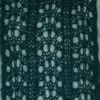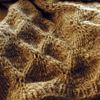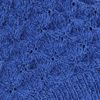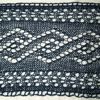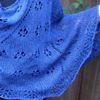
(Oct ’04)
Life is funny. Not long after I started this website, I heard from the parents of two of my childhood friends, Wendy and Tracy. They have known me since I was born—and they had retired to Chincoteague Island! (See the Embossed Diamonds entry.)I asked them if they’d adopted one of the local wild ponies, and got told with a laugh, all they have to do is walk outside if they want to see one. Click down for the rest of the story.
Pattern InstructionsI’ll give you the stitch pattern, and you can go swatch it with your own yarn, do the math, and turn it into whatever size and item you want. I started and ended with fourteen rows of k1p1 ribbing.
Row 1: *p1, k3, p1, k3, p1, yo, ssk, k5* across, ending p1 k3 p1 k3 p1.
Row 2 and all wrong side rows: purl.
Row 3: *p1, k3, p1, k3, p1, k1, yo, ssk, k4* across, ending p1, k3, p1, k3, p1.
Row 5: *p1, k3, p1, k3, p1, k2, yo, ssk, k3* across, ending p1, k3, p1, k3, p1.
Row 7: *p1, k3, p1, k3, p1, k3, yo, ssk, k2* across, ending p1, k3, p1, k3, p1.
Row 9: *p1, k3, p1, k3, p1, k4, yo, ssk, k1* across, ending p1, k3, p1, k3, p1.
Note: Working on it as a scarf, I decided to reverse the order of the pattern, so I cast on 47 stitches, then started off the first row (wrong side) as p1, k1, p1, k1, p7, k1, p3, k1, p3, k1, p7, k1, p3, k1, p3, k1, p7, k1, p1, k1, p1. Note that I added an extra p1 and k1 to each edge, the one difference from the main pattern–this is to keep the edges from curling The k1p3k1p3k1 areas continue upwards as a wide ribbing, and the p7 areas (again, that’s looking at it from the wrong side, I just started) have the yo moving over by one stitch each right side row. It is a very simple, easy pattern for carrying around without having to carry your instructions with you, and another good lace pattern for beginners.
I get possums and skunks in my yard. They get ponies. I wanna move.
When I was nine years old, I was running through their house one summer day, and thought the storm door in the basement was ajar. (Note to my Californian neighbors, who have never heard of such a thing nor lived in hurricane country: that’s like a screen door, only with glass panels above and below.) I went to go push it the rest of the way open with my outstretched hand as I ran–and the two faded diagonal scars on my arm attest to the fact that, no, dear, it was shut tight. I had just long enough to think in amazement, “I didn’t know glass bends!” before it wasn’t bending anymore.
Not long after I heard from Wendy and Tracy’s folks, I started knitting a baby alpaca afghan for another old childhood friend, Kathleen. I doodled a bit with my yarn and came up with this pattern and liked it, but after I’d done the second repeat in the afghan it somehow felt very much complete. Done. That made no sense. It took awhile before I made the connection between that feeling and how the pattern mirrored my arm. Two scars would be plenty, then! But the afghan went on, just like we all pick up the pieces (or in the case of my arm, pick out the pieces in the local ER) after our various hurts, and continue on. And over time, we find our wounds soften us, make us kinder, if we allow it. When we let them be visible, they can become the warmth by which others are drawn to us and find their own comfort. I thought of that as that soft yarn ran through my fingers, hour after hour, and as that pattern grew and grew to become something altogether different from whe I’d started.
I used about two pounds of baby alpaca, one in fingering weight, one a slightly heavier sportweight, knitted together on size 7 needles. Another half pound or so would have made a bigger afghan than the 62″ long one I got, and I would have preferred that, but I had less of one of the yarns than I would have liked. One was originally an orangey-brown in a since-discontinued yarn, the other more on the taupe side, called “musk,” a Henry’s Attic prime alpaca from my dear friend Lisa Souza, lisaknit.com . Both strands were originally undyed and straight from the animals’ backs. I used Jacquard acid dye in crimson with just a little bit of Jacquard purple added in to add a little more blue to the overall tone. I got a gorgeous deep burgundy with a heathered effect when I put them together. Still, they came out surprisingly close, given the separate dyelots and differing original shades.
As for how big an afghan should be, my general rule is, it should cover the recipient’s feet and go up to their chin when their feet are outstretched; anything smaller on a chilly evening makes them reach for something else instead. Basically, it should pretty much match their height.
Come to think of it, I probably owe one of these to Wendy and Tracy’s folks to pay for that window.
© Copyright Alison J. Hyde 2004, 2005, 2006, and 2007. All rights reserved.
Note to yarn store owners, there having been problems with copyright violations: you do not have my permission to print out copies of my patterns in your stores. Individuals only may print out copies at home for their own private and personal use. Questions may be addressed to me at spindyeknit AT gmail DOT cahm.
